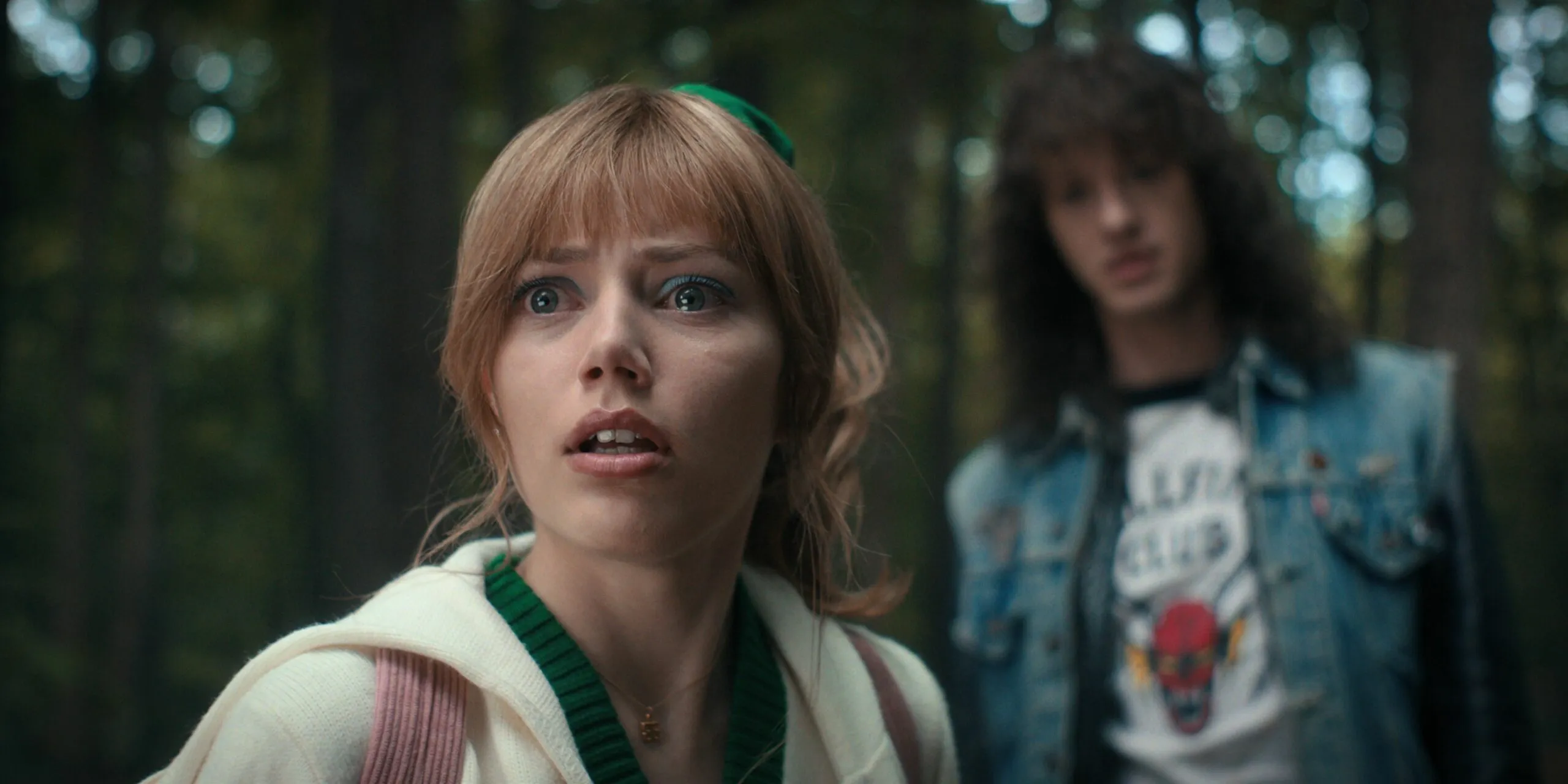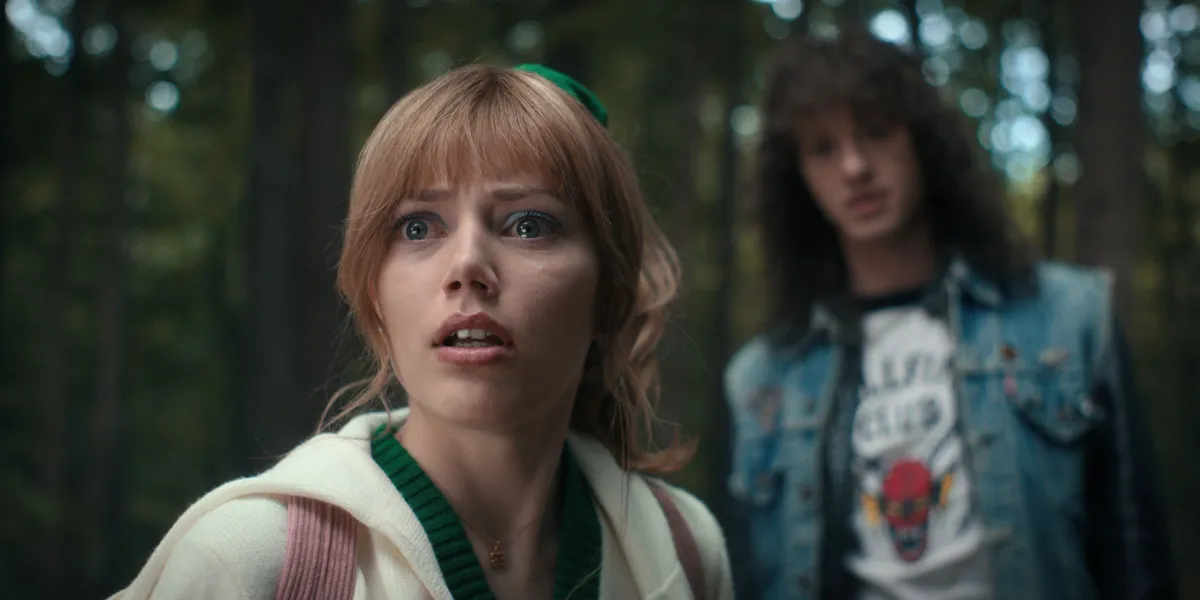Chrissy Cunningham and How ‘Stranger Things’ Tricks Us Into Loving Doomed Characters
Oh Chrissy, if only you'd had your walkman.

If there’s one thing Stranger Things knows how to do, it’s kill off an adored character. From Barb’s tragic death (and the ensuing public outcry) to Eddie’s untimely death-by-bats in the recent season four volume two finale, Stranger Things seems to have carved a niche for itself by crafting lovable one-off characters that are introduced, quickly endeared to the audience, and then subsequently brutally murdered just when we were starting to realize how much we loved them. Whether they’re around for a single episode or a single season, these one-off characters pop up in every new Stranger Things season without fail—we all know it’s coming, we all know they’re going to bite it sooner rather than later, but we grow to care about them anyway.
So how do they do it? How does Stranger Things keep getting us to fall in love with characters that both the series and the audience know aren’t going to last through the season? Though season four introduced no shortage of one-off characters that would be killed before the credits rolled, one particular Vecna victim made a lasting impression (and spawned an earworm of a TikTok song) with her extremely meager screentime: Grace Van Dien’s Chrissy Cunningham.
For the uninitiated, when we first meet Chrissy Cunningham, she’s immediately marked for death in the eyes of the audience: her one-episode arc is used as the introduction to the motives and means of Vecna, season four’s big bad. In between kicking off the rest of season four’s over-arching plotlines, the season four premiere takes us through the final hours of Chrissy’s life. Ever-worsening nightmares and hallucinations (caused by Vecna but stemming from her emotional trauma and mental health issues) drive her to seek out drugs from local dealer, Eddie Munson (the other wildly popular breakout and doomed character of the season). The rest, of course, is TV history. After a borderline meet-cute in the woods, Eddie and Chrissy’s blossoming dynamic is quickly cut short when Chrissy is murdered by Vecna in front of Eddie—a gruesome, disturbing sequence that brings a brutal end to episode one.
As it is for most major horror franchises, the tradition of introducing a sympathetic character only to immediately kill them off is standard practice by now for Stranger Things, and as for as horror first kills go, Chrissy fits the brief to a tee’ From outward appearances, she’s the picture perfect victim and a common 80s cliche: the pretty, peppy, straight-laced cheerleader dating the captain of the basketball team. But as evidenced by the passionate fan response to her character even after she’d long since been killed off, Chrissy Cunningham is anything but the conventional cheerleader stereotype that her role on the show might otherwise demand her to be.
It’s not secret that Stranger Things, especially in its later seasons, has enjoyed paying homage to and taking queues from vintage pop culture references, and the “mean cheerleader” is not only an 80s teen movie staple, but a frequent slasher victim. So on paper, it would make most sense for the series to introduce Chrissy as a similarly cruel archetype—someone to act as the Hawkins High equivalent of Angela, Eleven’s tormentor in the California-set scenes of season four.
As anyone who’s seen the season four premiere can attest, though, a shallow, cruel cheerleader Chrissy certainly isn’t. Instead, like Barb and the countless other one-off characters who came before her, Chrissy is given remarkable depth in her short time onscreen. She’s a sweet, soft-spoken, multi-faceted young woman with a tragic home life and more than enough charm to endear both Eddie and the audience to her, just as she meets a cruel end at Vecna’s hand.
Part of what makes Chrissy so effective as an introductory Vecna victim is that the emotionality and tragedy of her story help lay the groundwork and foreshadowing for how Vecna will pick his later victims: he preys on the isolated, the fearful, the hopeless. He deliberately seeks out prey that he knows have nowhere else to turn, and no support system to lean on—and this entire element of his hunting tragedy is heartbreakingly demonstrated in Chrissy’s brief but effective screentime.
Instead of being stricken by the death of a loved one like Max was, Chrissy’s trauma stems from her troubled home life. She endures constant body shaming and emotional abuse from her mother Laura, which eventually drives Chrissy to bulimia—a development revealed when Max crosses paths with her in the bathroom. But while Max (to no avail) at least attempted to ask if Chrissy was all right, what’s most heartbreaking, is how blind the people closest to her are about how much Chrissy was struggling.
Even after she’s dead and buried, there are constant references to Chrissy peppered throughout season four, many of which hinge around others’ disbelief that Chrissy could have been in any way haunted or conflicted. When Max tells the Party she saw Chrissy heading to Eddie’s trailer, Dustin is incredulous that ‘prissy Chrissy’ would have any reason to buy drugs—and when confronted by the police, Chrissy’s boyfriend Jason is in constant denial over the fact that she may have been struggling with self esteem or mental health of any kind.
Chrissy’s tragic life—and the way in which her family and loved ones don’t seem to understand, acknowledge, or even notice her pain—is a thoughtful commentary on both the pressures of maintaining social status and outward appearances in high school, and the deceptive nature of mental health: how even those who seemingly ‘have it all’ can cry for help without anyone taking the time to really listen. The writing is strong in and of itself, but when combined with Grace Van Dien’s beautiful performance, which is at once charming and heartbreaking, watching Chrissy struggle when we know she’s not going to make it is as effective as it is devastating. (As for how the season treated the through-line theme of trauma on the whole, however, other Mary Sue writers have expressed disappointment as well as lauded some elements of how Stranger Things depicted PTSD.)

While Chrissy’s relatable struggles with body image, anxiety, and mental health endeared her to many fans, though, it isn’t just the more tragic parts of her character that resonated with viewers. As evidenced by the plethora of social-media support and fan content, her brief but chemistry-filled scenes with drug dealer Eddie Munson (Joseph Quinn) immediately endeared viewers, and had audiences decrying how quickly their relationship was extinguished before it could begin. A popular ship, “Edissy,” emerged in fandom to further explore what might have been.
It’s true that much of her story was clouded in tragedy and tangled up under Vecna’s influence, but Chrissy’s scenes with Eddie, particularly the forest drug deal-turned meet-cute, feel more like moments ripped straight out of an 80s romantic comedy. The duo certainly makes a dynamic visual pair: invoking the likes of The Breakfast Club’s Claire and Bender, or Grease’s Danny and Sandy, and their ‘opposites attract’ appeal combined with the instant chemistry between Van Dien and Quinn makes a sweet pair who (in another life) are surely rocking out to Metallica somewhere.
Even outside of her instantly-iconic scenes with Eddie, though, Chrissy Cunningham is still absolutely a compelling and easy-to-love character in her own right: not just a misunderstood victim, but a well-written, complexly performed supporting character who could easily have folded right in with the rest of the Hawkins gang. Popular yet lonely, beautiful yet wracked with insecurity, and guarded yet sweet, Stranger Things’ Chrissy Cunningham is a masterclass in the art of creating a tragic horror first kill, and one of the show’s most compelling characters across four seasons, despite less than ten minutes of screentime.
(image: Netflix)
Have a tip we should know? [email protected]